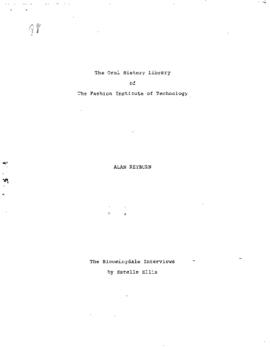Cropped figure clutching head; Color: markers; Signed
Sans titreLarge stylized figure in red jacket and black pants with green/white checkered floor; Color: marker and color film; Signed
Sans titreFigure in off-shoulder print robe with round, starry perfume bottle; Color: pastel; Signed
Sans titrePicasso-like double view head with perfume. "Opium."; Color: pastel; Signed
Sans titre"Winter 1980." Three Cubist male heads with snowy background; Color: pastel; Signed
Sans titreRobert L. Green interviews photographer Karl Gernot Keuhn about his life and career as a photographer. They spend a considerable amount of time discussing Gernot Keuhn's project photographing elderly female Hollywood celebrities, and view photographs taken by Keuhn.
Sans titreFigure seated on pillows in ethnic inspired outfit; Color: marker and pastel; Signed
Sans titre"Pinky and Diane." Three stylized heads; Color: printed poster; Signed
Sans titreFigure in salmon pink dress and black shawl. Sole of shoe imprint; Color: pastel; Signed
Sans titreStylized head with round perfume bottle; Color: pastel; Signed
Sans titreLinda Morand interviews model Chris Royer, where Royer shares her career growth, past experiences, favorite campaigns, work with Halston, model relationships, and general modeling memories. Royer even gives out some of her beauty secrets and provides advice for young aspiring models.
Sans titreEleanor Fried, the first head of the Fashion Institute of Technology (New York, N.Y.)’s placement office, discusses her upbringing and the circumstances that led her to the Fashion Institute of Technology (New York, N.Y.) in 1947, shortly after its founding. She describes the early academic departments at the Fashion Institute of Technology (New York, N.Y.) and its demographics. Fried then details the institute’s successful management program and how the placement office went about developing close relationships with department stores and other employers in the Industry. Fried emphasizes the vocational maturity of many of the Fashion Institute of Technology (New York, N.Y.)’s two-year graduates, but explains that some students chose to go on to four-year degrees elsewhere. While the placement department was extremely successful in placing most students, it was severely understaffed; so Fried often ended up employing students to help with outreach. She explains how she stayed in contact with alumni and asked for their ongoing input regarding the school’s curriculum. Fried then describes the positive changes brought about by affirmative action, especially in regards to staffing her office. She finishes the interview by describing a book she published following her retirement as well as two she wrote while at the Fashion Institute of Technology (New York, N.Y.) including, “Is The Fashion Business Your Business?”
In this interview, Alan Reyburn talks about restuaranteuring in the context of the retail world. Reyburn ran all food operations at Bloomingdale's during the 1980s, including staff restuarants. After briefly describing his past hospitality job working for a cruise line, Reyburn explains that New York City is a restaurant city and the Bloomingdale's client is someone who considers food and dining to be part of the fashionable lifestyle. Reyburn attributes Bloomingdale's Marvin S. Traub for having the total vision that included food operations as part of the Department Store's success. Most notable among Reyburn's projects while at Bloomingdale's was Le Train Bleu, a rooftop restuarant designed to look like the luxury train used by travelers going between Paris and the Mediterranean. Reyburn shares a number of anecdotes about the inception, operation, and overall concept of Le Train Bleu. As Bloomingdale's was one of the few department stores to have its own restuarant at the time, Reyburn explains the challenges specific to running a restaurant within a retail environment. In regards to service, Reyburn believed that good service in the restaurant was even more important to the Bloomingdale's client than good service on the sales floor. Having traveled with Traub for business, Reyburn describes the Bloomingdale's CEO as being indefatigable, an adventurous eater, and keenly aware of his surroundings. He also describes Traub as having more vision than most retailers, seeing a broader picture and having a shorter temper.
Sans titreInterview of James Preston, Chairman Avon Products about Annette Green and the Fragrance Foundation, 1993 August 26. This interview discusses Preston's opinions and admiration for Green and the work she did for the Fragrance Foundation.
Sans titreIn this interview, Paul Winston talks about his early career, working for his father's company in the 1960s, his own company, and the men's Ivy League fashion business.
Sans titreVolume 6 contains coverage of Mainbocher's Fall/Winter 1945 and Spring/Summer 1946 collections. His fall collection was the first since the Americans won the war. It featured embroidery placed on bodices, draperies, peplums and belts. Black was the basic color. Short, double-breasted flannel jackets looked deceptively simple on the outside but were lined in ermine or seal skin. His jeweled necklines that he had introduced three years earlier prevailed. The spring collection had a "young and contemporary" look with emphasis on the slim line. He used less black. Yellow was the dominant color. The volume includes an article from LIFE entitled "Mainbocher is 'Cheapest' Dressmaker," published May 20, 1946. Folders contain a contents page; an original copy of Magazine Madeleine from November 1946; and an International News photograph of Mainbocher and Mrs. John C. Wilson, in which she wears the same dress she models in the May 1946 edition of Vogue.





